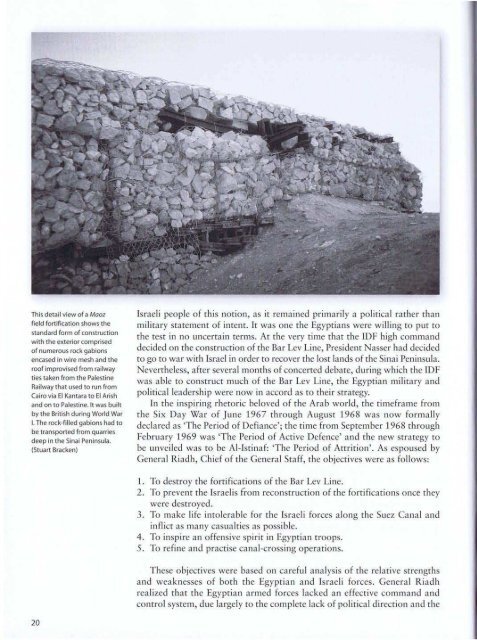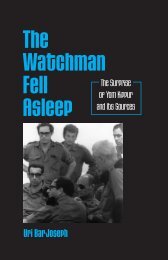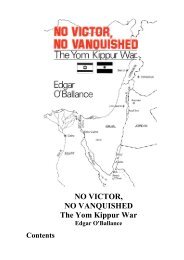israeli fortifications of the october war 1973
israeli fortifications of the october war 1973
israeli fortifications of the october war 1973
You also want an ePaper? Increase the reach of your titles
YUMPU automatically turns print PDFs into web optimized ePapers that Google loves.
This detail view <strong>of</strong> a Maoz<br />
field fortification shows <strong>the</strong><br />
standard form <strong>of</strong> construction<br />
with <strong>the</strong> exterior comprised<br />
<strong>of</strong> numerous rock gabions<br />
encased in wire mesh and <strong>the</strong><br />
ro<strong>of</strong> improvised from railway<br />
ties taken from <strong>the</strong> Palestine<br />
Railway that used to run from<br />
Cairo via EI Kantara to EI Arish<br />
and on to Palestine. It was built<br />
by <strong>the</strong> British during World War<br />
I. The rock-filled gabions had to<br />
be transported from quarries<br />
deep in <strong>the</strong> Sinai Peninsula.<br />
(Stuart Bracken)<br />
20<br />
Israeli people <strong>of</strong> this notion, as it remained primarily a political ra<strong>the</strong>r than<br />
military statement <strong>of</strong> intent. It was one <strong>the</strong> Egyptians were willing to put to<br />
<strong>the</strong> test in no uncertain terms. At <strong>the</strong> very time that <strong>the</strong> IDF high command<br />
decided on <strong>the</strong> construction <strong>of</strong> <strong>the</strong> Bar Lev Line, President asser had decided<br />
to go to <strong>war</strong> with Israel in order to recover <strong>the</strong> lost lands <strong>of</strong> <strong>the</strong> Sinai Peninsula.<br />
Never<strong>the</strong>less, after several months <strong>of</strong> concerted debate, during which <strong>the</strong> IDF<br />
was able to construct much <strong>of</strong> <strong>the</strong> Bar Lev Line, <strong>the</strong> Egyptian military and<br />
political leadership were now in accord as to <strong>the</strong>ir strategy.<br />
In <strong>the</strong> inspiring rhetoric beloved <strong>of</strong> <strong>the</strong> Arab world, <strong>the</strong> timeframe from<br />
<strong>the</strong> Six Day War <strong>of</strong> June 1967 through August 1968 was now formally<br />
declared as 'The Period <strong>of</strong> Defiance'; <strong>the</strong> time from September 1968 through<br />
February 1969 was 'The Period <strong>of</strong> Active Defence' and <strong>the</strong> new strategy to<br />
be unveiled was to be AI-Istinaf: 'The Period <strong>of</strong> Attrition', As espoused by<br />
General Riadh, Chief <strong>of</strong> <strong>the</strong> General Staff, <strong>the</strong> objectives were as follows:<br />
1. To destroy <strong>the</strong> <strong>fortifications</strong> <strong>of</strong> <strong>the</strong> Bar Lev Line.<br />
2. To prevent <strong>the</strong> Israelis fi'orn reconstruction <strong>of</strong> <strong>the</strong> <strong>fortifications</strong> once <strong>the</strong>y<br />
were destroyed.<br />
3. To make life intolerable for <strong>the</strong> Israeli forces along <strong>the</strong> Suez Canal and<br />
inflict as many casualties as possible.<br />
4. To inspire an <strong>of</strong>fensive spirit in Egyptian troops.<br />
5. To refine and practise canal-crossing operations.<br />
These objectives were based on careful analysis <strong>of</strong> <strong>the</strong> relative strengths<br />
and weaknesses <strong>of</strong> both <strong>the</strong> Egyptian and Israeli forces. General Riadh<br />
realized that <strong>the</strong> Egyptian armed forces lacked an effective command and<br />
control system, due largely to <strong>the</strong> complete lack <strong>of</strong> political direction and <strong>the</strong><br />
extraordinary autonomy and unpr<strong>of</strong>essionalism displayed by some senior<br />
<strong>of</strong>ficers: prior to <strong>the</strong> Six Day War many were more concerned with <strong>the</strong><br />
running <strong>of</strong> lucrative sporting clubs in Cairo than <strong>the</strong> pr<strong>of</strong>ession <strong>of</strong> anns. In<br />
addition, both <strong>the</strong> Air Force and <strong>the</strong> Navy acted as independent organizations<br />
with no concerted control at all. These problems were rigorously addressed<br />
with many more senior appointments being made on merit ra<strong>the</strong>r than<br />
patronage. The integration <strong>of</strong> command structures embracing <strong>the</strong> Army,<br />
avy and Air Force proceeded apace. A new Air Defence Command was<br />
created in July 1968 to coordinate all anti-aircraft artillery (AAA) and<br />
surface-to-air missile (SAM) units in order to blunt <strong>the</strong> superiority <strong>of</strong> <strong>the</strong> IAE<br />
In October 1967, General Riadh was given an affirmation <strong>of</strong> <strong>the</strong><br />
Egyptians' ability to employ sophisticated weapon systems when <strong>the</strong> INS<br />
Eilat was sunk by Styx anti-ship missiles on his birthday. While <strong>the</strong><br />
weaknesses <strong>of</strong> <strong>the</strong> Egyptian armed forces were addressed, <strong>the</strong> Egyptian high<br />
command identified <strong>the</strong> areas <strong>of</strong> Israeli dominance as <strong>the</strong>ir superiority in air<br />
combat and in manoeuvre <strong>war</strong>fare. The former was to be countered by <strong>the</strong><br />
expansion <strong>of</strong> SAM units equipped with <strong>the</strong> SA-75 Dvina system, commonly<br />
know by its NATO designation as <strong>the</strong> SA-2 Guideline, and <strong>the</strong> latter by <strong>the</strong><br />
massive employment <strong>of</strong> Soviet anti-tank weapons such as <strong>the</strong> Ruchnoy<br />
Protivotankovy Granatomyot, or RPG rocket-propelled grenade, and <strong>the</strong><br />
9M14 Malyutka (NATO codename AT-3 Sagger). The intention was to<br />
saturate any Israeli armoured <strong>of</strong>fensive by a mass <strong>of</strong> missiles and RPGs while<br />
main battle tanks and self-propelled guns acted as direct-fire support weapons<br />
behind <strong>the</strong> infantry screen.<br />
An M50 155mm self-propelled<br />
howitzer undertakes a fire<br />
mission during <strong>the</strong> War <strong>of</strong><br />
Attrition. Artillery was <strong>the</strong><br />
principal weapon employed<br />
by <strong>the</strong> Egyptian Army during<br />
<strong>the</strong> protracted conflict using a<br />
wide array <strong>of</strong> Soviet ordnance.<br />
On many occasions for<strong>war</strong>d<br />
observation teams were<br />
infiltrated into <strong>the</strong> Sinai<br />
Peninsula to provide accurate<br />
target information to <strong>the</strong><br />
waiting guns that caused<br />
a debilitating rate <strong>of</strong> IDF<br />
casualties, with black-edged<br />
photographs <strong>of</strong> fallen soldiers<br />
appearing with appalling<br />
regularity in Israeli newspapers.<br />
Starved <strong>of</strong> modern weapon<br />
systems, <strong>the</strong> IDF artillery<br />
branch was hard pressed to<br />
counter <strong>the</strong> pr<strong>of</strong>ligate number<br />
<strong>of</strong> Egyptian artillery pieces and<br />
mortars employed during <strong>the</strong><br />
War <strong>of</strong> Attrition.




